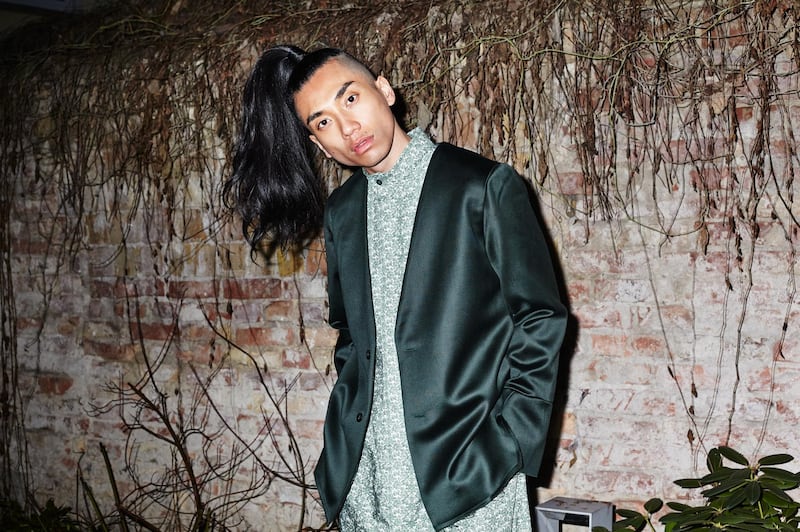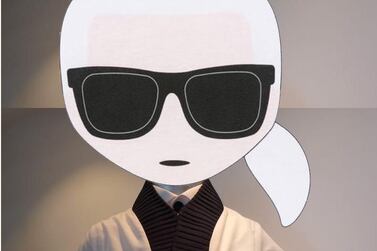Fashion design often operates, quite deliberately, at two extremes: it either presents itself as completely apolitical or exists to make a statement. Nour Hage, a Lebanese designer who resides in London, treads a more nuanced path, one with a strong social message. Inspired by Arab culture and targeting young Arabs and South Asians who take pride in their roots, her designs look to traditional cuts and silhouettes, but are realised in contemporary and versatile styles.
Hage is unusual in other ways, too. She is an environmentalist who works in the world’s second-most polluting industry. And although she was formally trained in designing womenswear, she is one of the only young Arab female designers today who has chosen to specialise in designing for men. A step she made recently.
A move into menswear
Two collections into her new role as a menswear designer, Hage and her clothes have already caught the attention of several famous figures. Firas Abou Fakher, guitarist and keyboardist with Lebanese indie band Mashrou' Leila, wore a bright blue abaya designed by Hage, at a concert in New York last year. And Riz Ahmed, an Emmy-winning British actor and activist of Pakistani descent, known for his refusal to conform to Hollywood stereotypes, wore two of Hage's designs for a photoshoot with GQ magazine in September.
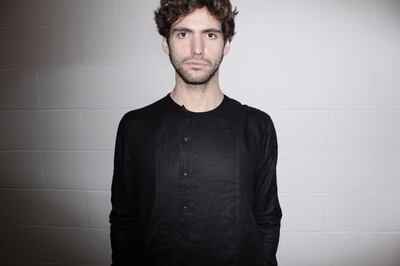
It's men such as these – young, daring, socially and politically engaged – that Hage hoped to attract when she set out to celebrate and update traditional Middle East garments, from thobes and abayas to collarless shirts and satras. Her clothes aren't targeted specifically at Arab clients, but at a new generation of men who "want to wear clothes that say something about their vision of the world – their openness and their curiosity about cultures and traditions", she explains.
Spring / summer 2019
This month, Hage released her spring / summer collection, 02: In Lands Akin to Yours, centred on Palestinian garments. She was inspired by writer, researcher and oral historian Yazan Kopty's project Imagining the Holy, a collection of unpublished photographs taken in Palestine since 1909 by the National Geographic Society. Kopty uses them to counter the erasure and appropriation of Palestinian culture, while Hage has based her range on the beautiful clothing worn by the men in these archival images.
Using linen and cotton, Hage created long, tailored shirts, fastened off-centre with a row of buttons; and loose, draped short-sleeved jackets covered with swirling patterns in greys and fawns. Unexpected details give her pieces an edgy, contemporary feel, such as the small, asymmetric panels of contrasting fabric she places at the bottom left of each of her long thobe-like shirts. Her first menswear collection, called Zero One, was characterised by flowing shapes and vivid colours. A dramatic floor-length thobe covered with a fine leaf print in cream and grey-green was paired with a sharp black blazer, and a voluminous jacket was constructed from a rich gold fabric. Hage's style, which contrasts minimalist design with eye-catching materials and patterns, is inspired both by her love for Japanese clothing and her research into traditional Arab garments.
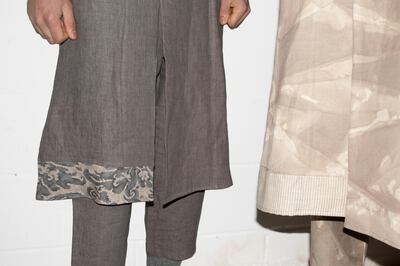
“The clothing was quite minimalistic, but the fabrics have always been very rich, whether in the embroidery or the patterns or the weaving or the colours,” she says. “Men used to dress colourfully in the region. Why did we just stop? I wanted to bring that back. There’s a softness in the way Arab men have always dressed, especially in the Gulf countries and in North Africa, and I wanted to translate that – softness in the fabric, softness in the shapes. It’s not too rigid and structured, and it gives room for movement,” she adds.
'Much more versatile'
Working closely with her friend Sultan Al Darmaki, a prominent Emirati shoe designer, on her first collection, Hage based one of the pieces on a custom thobe she designed for Al Darmaki, which features slits up the sides, allowing him to wear it over trousers. Other traditional garments were also reimagined to suit current tastes, using lighter fabrics and simpler fastenings. "The garments are much narrower to the body than traditionally, because modern men want to wear things that are slimmer," she explains. "The items are much more versatile."
Hage says the reception her collections have received is a pleasant surprise. Women as well as men are drawn to her unusual garments and the concept behind them. "The brand is rooted not only in Arab identity, but also in storytelling and cultural references, so there is always a message that I want to put out or a story that I want to tell."
The idea of clothes and how they could assert individuality first piqued Hage's interest while she was still at school. Bored by the uniform, she started experimenting with ways to stand out. In her first year at Parsons Paris School of Art and Design she decided that her calling lay in fashion design. She elected to study ready-to-wear womenswear because, she says, she didn't know that menswear could be interesting. After stints at Elie Saab and Oscar de la Renta, she landed a job working with German designer Damir Doma in Paris, and it was there that she fell in love with the subtleties of men's fashion.
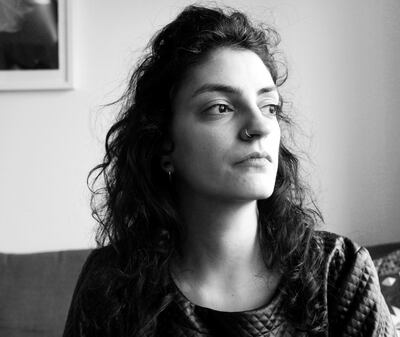
In 2013, Hage established her own label in Lebanon, but the market revolved around womenswear, and it wasn’t until she moved to London a couple of years ago that she could realise her dream of designing mould-breaking menswear. “I think it’s less stigmatised for women to explore and be more adventurous with how they dress,” she muses. “But in the past few years, we’re seeing a change in the menswear market and men are being more adventurous … It’s more acceptable nowadays for men to try different things.” Her timing was perfect.
When style meets practicality
Hage relishes the demands of designing for a male market. “Because men tend to shop for comfort and practicality before aesthetics, I find that’s more of a challenge to design – how to create something new and innovative within those constraints,” she says.
She also imposes her own constraints, driven by a passion for ethical, sustainable fashion. Her new collection is made using Italian and Belgian linen, and Spanish cotton sourced from failing factories in Europe and destined for landfill.
Each piece is specifically designed to minimise wastage and is made in the same small factory in the hills above Beirut, run by a tailor trained in Italy and France, who pays his staff fair wages and ensures they all work humane hours.
"I don't buy a lot of clothes and I'm very careful about how I consume things," adds Hage, whose parents were also environmentalists. "If I have a hole in my clothes, I fix it – even my socks. I tend to wear things completely out before they're discarded, and that's how I want people to wear the clothes that I design."
